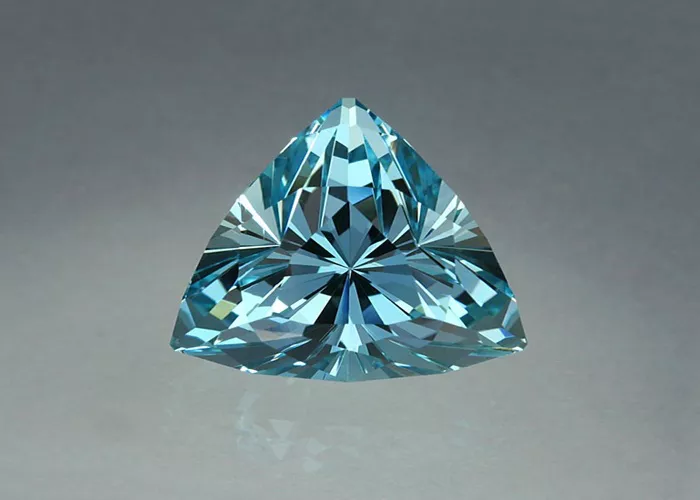Aquamarine is a beautiful gemstone known for its stunning blue color. The name comes from the Latin words for water and sea, which perfectly describe its ocean-like hues. This gem is a variety of the mineral beryl, the same family as emerald. Unlike emerald, which is green, aquamarine ranges from pale blue to deep blue-green. The color is caused by traces of iron in the crystal structure. The most valuable aquamarines have a rich, medium blue tone without any green. Lighter stones are more common and usually less expensive.
Why Aquamarine Stands Out
One of the most special things about aquamarine is its clarity. Unlike many gemstones, aquamarine often forms with very few inclusions, making it clean and transparent. This clarity allows light to pass through easily, giving it a brilliant sparkle. When cut well, an aquamarine can look like a piece of the sea captured in a gem. Jewelers love working with this stone because it is durable, with a hardness of 7.5 to 8 on the Mohs scale. This means it resists scratches well and is suitable for everyday jewelry like rings and bracelets.
The History and Symbolism of Aquamarine
Aquamarine has been treasured for centuries. Ancient sailors believed it would protect them during ocean voyages. They thought the stone could calm storms and ensure safe travels. Even today, many people wear aquamarine as a symbol of courage and tranquility. It is the birthstone for March, making it a popular choice for birthday gifts. Some also believe it has healing properties, such as reducing stress and improving communication. Whether or not you believe in these powers, there is no denying the stone’s natural beauty.
Where the Finest Aquamarines Are Found
The best aquamarines come from Brazil, but they are also found in countries like Nigeria, Madagascar, and Pakistan. Brazilian aquamarines are famous for their deep blue color, sometimes called “Santa Maria” after the mine where they were first discovered. Larger aquamarines are more common than other precious gems, which is why you can find impressive sizes in jewelry. Some famous aquamarines weigh hundreds of carats and are displayed in museums.
How to Choose the Perfect Aquamarine
When buying aquamarine, color is the most important factor. The deeper and more vivid the blue, the more valuable the stone. Cut is also crucial because it affects the gem’s brilliance. A well-cut aquamarine will reflect light beautifully. Since most aquamarines are naturally light, some are heat-treated to enhance their color. This treatment is widely accepted in the jewelry industry as long as it is disclosed.
Aquamarine in Jewelry Design
Aquamarine looks stunning in many jewelry styles. It pairs well with white metals like silver, white gold, and platinum, which highlight its cool blue tones. It is often used in engagement rings, earrings, pendants, and statement necklaces. Because of its clarity, it is frequently cut in step cuts like emerald or Asscher cuts, but it also shines in round or oval shapes. Designers sometimes combine aquamarine with diamonds to add extra sparkle.
Caring for Your Aquamarine Jewelry
Caring for aquamarine is simple. It can be cleaned with warm soapy water and a soft brush. Avoid harsh chemicals and extreme heat, which could damage the stone. With proper care, an aquamarine can last for generations, making it a meaningful heirloom.
Why Aquamarine Remains Timeless
In conclusion, aquamarine is a unique and captivating gemstone. Its serene blue color, excellent clarity, and durability make it a favorite among jewelers and collectors. Whether you choose it for its beauty, history, or symbolic meaning, aquamarine is a gem that will always stand out. Its connection to the sea gives it a timeless appeal, making it a perfect choice for anyone who loves the ocean or simply appreciates fine jewelry.
Conclusion
In summary, aquamarine is a captivating gemstone within the beryl family, renowned for its alluring blue to blue – green shades stemming from iron traces in its crystal structure. Its outstanding clarity, durability with a Mohs hardness of 7.5 – 8, and wide availability in various sizes, especially from Brazil, contribute to its popularity. With a rich history of being a talisman for sailors and symbolizing courage and tranquility, along with its status as the March birthstone, aquamarine holds both aesthetic and symbolic value. When selecting an aquamarine, color and cut are key factors, and heat – treatment is a common way to enhance its appearance. In jewelry design, it pairs exquisitely with white metals and is versatile in different cuts and settings. Simple care with warm soapy water keeps it in top condition. Overall, aquamarine’s unique blend of beauty, history, and practicality ensures its enduring appeal in the world of fine jewelry.
Related Topics:
- The Birthstone for March 28: A Deep Dive into Aquamarine
- What is the Birthstone for March 26?
- March 25 Birthstone: Why Aquamarine is Perfect for You


